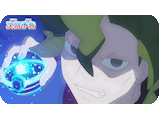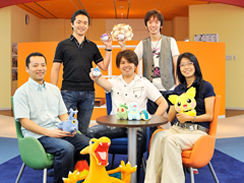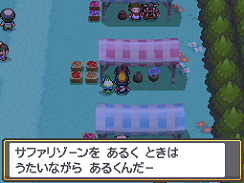
Special Chat"



Main
Old Updates Archive
Links
 |
Lists |
List of Pokemon
Pokemon World Atlas
List of Techniques
List
of Items
List of Anime Episodes
 |
Guides |
Episode Comparisons
Movies
& Specials Guide
CD Guide
DVD Guide
Voice
Actors Guide
Lyrics Archive
Manga Guide
Video
Games
 |
Miscellaneous |
Humor
Pokemon Bashing
Features
Rants
Dogasu's Backpack
| Features
| A Pokemon Music Special Chat
The CD
release for the soundtrack to the Nintendo DS games Pocket Monsters HeartGold and SoulSilver was released on October
28th, 2009. Included in the three-disc set was a booklet
containing a detailed track listing, information about the games, and a
six-page interview with the staff who worked on the game's music.
The following is my translation of the interview, followed by a few footnotes at the end. The footnotes were not part of the original interview.
This interview with the Pocket Monsters HeartGold and SoulSilver music team - Masuda Jun'ichi, Ichinose Gou, Kageyama Shouta, Satou Hitomi, and Kitsuta Takuto - was conducted on July 30th, 2009.

To begin with, please introduce yourselves and tell us what you were in charge of.
Ichinose Gou: "I was in charge as the sound leader and supervised the compositions, the arrangements, and the rest of the project."
Kageyama Shouta: "I was responsible for transferring the music to the game and for creating the background music, the arrangements for the ME, and for creating the new pieces. Later, I was in charge of recreating the original Game Boy music."
Satou Hitomi: "I was in charge of the music brought over from Platinum to HeartGold and SoulSilver. I also worked on some of the new music, like the Safari Zone themes."
Kitsuta Takuto: "I mainly worked on the arrangements for the Kanto region music."
Masuda Jun'ichi: "I worked with Mr. Ichinose on the original Gold and Silver music. This time, I supervised the project as a producer.
One of the most surprising things one notices is that there are five people on this game's music team. Why do you think this project required a team this big?
Ichinose: "In the planning stage, we added new facilities, new events, and the GB Player. So, the number of songs gradually rose. Another factor was the sound effects, like the natural sounds you hear when you're standing by places like the rivers and the sea. These really gave us a huge number of tracks to make."
Masuda: "Moreover, the original Gold and Silver also had a large number of tracks. We wanted to make sure that each track was as high quality as the originals were, so we needed the large team."
Could you tell us about the theme of the new songs created for HeartGold and SoulSilver?
Kageyama: "One of the new elements of the game is the Pokethlon (Disc Two, Tracks 40-49), and we made the music to feel like a more grand version of an athletic meet. We paid attention to small things, like synching up the music to the "3...2...1...Start!" countdown at the beginning of the competitions. We thought that players would appreciate this attention to detail."
 Satou:
"I was in
charge of the music to Route 471 and the Safari Zone (Disc Two, Tracks
31-33). Route 47 is in the countryside, so we tried to make
players wonder what kind of place they're heading for. When you
finally arrive at the Safari Zone, you unexpectedly see a lot of
people, and I think this gap is interesting."
Satou:
"I was in
charge of the music to Route 471 and the Safari Zone (Disc Two, Tracks
31-33). Route 47 is in the countryside, so we tried to make
players wonder what kind of place they're heading for. When you
finally arrive at the Safari Zone, you unexpectedly see a lot of
people, and I think this gap is interesting."
"The Safari Zone theme also has lyrics2. One of the boys at the gate to the Safari Zone sings them; try singing along sometime!"
Ichinose: "I couldn't figure out how to do Lugia's battle theme (Disc Two, Track 75) at first. At that time, if I asked Mr. Masuda to come by my desk and tell me his image of the theme, he would only play three or four notes. It seems ridiculous, but he was able to convey his message in those few notes. After that, I was able to finish the song easily."
"The most difficult song for me was Hou'ou's battle theme (Disc One, Track 87). I had imagined Hou'ou as a very peaceful creature, but I was worried that the song would be too peaceful and take the player out of the battle experience. My proposals kept getting turned down for not expressing Hou'ou's power and its glory, and I barely made my deadline. I did eventually finish it, but I feel like I had to tone down that sense of "peace" to do it."
What were you thinking about when working on the arrangements for the Gold and Silver tracks?
Ichinose: "I worked on the music for the original Gold and Silver. I wanted to rework the arrangements to do things that the DS can do that the original Game Boy could not, but when I thought about the old fans wanting the music to retain its old charm, I didn't want to betray their expectations. I was tempted, though, and I apologize if any of the fans feel betrayed (laughs)."
Kageyama: "I also wanted to live up to the originals and I also really didn't want to turn my back on the older fans. The Game Boy only had three sound channels3, and we really tried to push the hardware to its limits. With HeartGold and SoulSilver, the quality could be improved and we could focus more on the beauty of the sounds. We really feel like the music evolved."
Satou: "The music in the original games was composed with the Game Boy's three-channel limit in mind. We thought that it was best to create memorable melodies, but we also had people interested in things like sub melodies and grace notes. So, we were careful to keep as many of those elements from the three-channel originals as possible."
Kitsuta: "I wondered how to retain the nuances of the original tracks in the new versions. That was my theme. The original songs were created with that three channel limit, but the original composers' ideas for these songs weren't limited to that. Now we're able to add those additional arrangements that the composers have had in their head for all these years."
While we're on the subject of the old fans, let's talk about the GB Player music on this collection's third disc.
Ichinose: "There was never a CD release for the original Gold and Silver, so we thought we could use the GB Player to include the old versions of these tracks and make the fans happy. You can listen to the GB Player after collecting the game's sixteen Gym Badges, so we really aimed it for players who really gave it their all. For those fans who never played the originals, hearing these three channel versions could be a fresh experience."
Kageyama: "Even though we basically included the GB Player for nostalgia purposes, we also included Game Boy arrangements of the newer stuff. Things like HeartGold and SoulSilver's Pokethlon and the Kanto music that wasn't in the original Gold and Silver all got Game Boy-style compositions. Please go around one more time so you can hear all the Game Boy version songs!"
"We didn't just transfer the original versions over, either; we re-composed the songs from scratch. I think we faithfully recreated the sounds of the original songs, so please enjoy them!"
Could you please tell us your recommended songs, and why?
Masuda: "Arceus' song (Disc Two, Track 84) is my favorite out of all the songs I was in charge of. You first hear it when you bring Arceus along with you in HeartGold and SoulSilver. It has a slightly scary feeling to it since Arceus is a god who's superior to everything."
Ichinose: "Out of the ones I arranged, "Nature Park" (Disc One, Track 58) stands out because Mr. Kageyama recreated a luxurious piano synthesizer for me at my request. I want people to hear this beautiful piano and feel like they were relaxing in a park. I also like the Shinto Ruins song (Disc Two, Track 83). The first part has a similar arrangement to the Mt. Tengan theme, but the second part includes different pokemon music themes. Please listen for it!"
Kageyama: "My recommendations are the songs for the support characters Hibiki (Disc Two, Track 15) and Kotone (Disc One, Track 6). In my own imagination, the main character is the support character's first love. I wanted to write a song that sounds like your heart is going to burst, but I don't think I did a good job."
"I also recommend the themes for Raikou (Disc One, Track 68), Entei (Disc One, Track 83), and Suicune (Disc Two, Track 13). Mr. Ichinose wanted me to emphasize each of their pokemon types, thinking we could make the fans happy if we did that."
Kitsuta: "Out of all the songs I arranged for the GB Player, I recommend the "Safari Zone Gate" (Disc Three, Track 83). The percussion plays a huge role in the song, so much so that It would be broken if we tried to remove it. So, we had to be crafty to recreate the percussion with the Game Boy's three channel limit. Please be sure to listen to it."
Satou: "My recommendation is "The Ice Loophole" (Disc One, Track 79). The Ice Loophole song was my favorite back in the Gold and Silver days, so we didn't change it too much - we just gave the song a more chilly arrangement."
"Another recommendation is "Ending" (Disc Two, Track 80). If you don't collect the eight Kanto badges, you can't hear this on the GB Player. We added a synthesizer-type sound to the melody to give it that Game Boy flavor so that people who play the game normally can listen to it and feel nostalgic."
Finally, we would like the producer, Mr. Masuda, to give us some impressions on HeartGold's and SoulSilver's music.
Masuda: "We really put a lot of effort in arranging these songs and creating new experiences. We hope your appetite is satisfied by these tracks."
Footnotes:
1Route 47 is an all-new route added to HeartGold and SoulSilver that connects Tanba City to the Jouto Region's Safari Zone. Back to the interview.
2The lyrics to the Safari Zone song, as sung by the boy outside the gate, are:
The following is my translation of the interview, followed by a few footnotes at the end. The footnotes were not part of the original interview.
This interview with the Pocket Monsters HeartGold and SoulSilver music team - Masuda Jun'ichi, Ichinose Gou, Kageyama Shouta, Satou Hitomi, and Kitsuta Takuto - was conducted on July 30th, 2009.

To begin with, please introduce yourselves and tell us what you were in charge of.
Ichinose Gou: "I was in charge as the sound leader and supervised the compositions, the arrangements, and the rest of the project."
Kageyama Shouta: "I was responsible for transferring the music to the game and for creating the background music, the arrangements for the ME, and for creating the new pieces. Later, I was in charge of recreating the original Game Boy music."
Satou Hitomi: "I was in charge of the music brought over from Platinum to HeartGold and SoulSilver. I also worked on some of the new music, like the Safari Zone themes."
Kitsuta Takuto: "I mainly worked on the arrangements for the Kanto region music."
Masuda Jun'ichi: "I worked with Mr. Ichinose on the original Gold and Silver music. This time, I supervised the project as a producer.
One of the most surprising things one notices is that there are five people on this game's music team. Why do you think this project required a team this big?
Ichinose: "In the planning stage, we added new facilities, new events, and the GB Player. So, the number of songs gradually rose. Another factor was the sound effects, like the natural sounds you hear when you're standing by places like the rivers and the sea. These really gave us a huge number of tracks to make."
Masuda: "Moreover, the original Gold and Silver also had a large number of tracks. We wanted to make sure that each track was as high quality as the originals were, so we needed the large team."
Could you tell us about the theme of the new songs created for HeartGold and SoulSilver?
Kageyama: "One of the new elements of the game is the Pokethlon (Disc Two, Tracks 40-49), and we made the music to feel like a more grand version of an athletic meet. We paid attention to small things, like synching up the music to the "3...2...1...Start!" countdown at the beginning of the competitions. We thought that players would appreciate this attention to detail."
 Satou:
"I was in
charge of the music to Route 471 and the Safari Zone (Disc Two, Tracks
31-33). Route 47 is in the countryside, so we tried to make
players wonder what kind of place they're heading for. When you
finally arrive at the Safari Zone, you unexpectedly see a lot of
people, and I think this gap is interesting."
Satou:
"I was in
charge of the music to Route 471 and the Safari Zone (Disc Two, Tracks
31-33). Route 47 is in the countryside, so we tried to make
players wonder what kind of place they're heading for. When you
finally arrive at the Safari Zone, you unexpectedly see a lot of
people, and I think this gap is interesting.""The Safari Zone theme also has lyrics2. One of the boys at the gate to the Safari Zone sings them; try singing along sometime!"
Ichinose: "I couldn't figure out how to do Lugia's battle theme (Disc Two, Track 75) at first. At that time, if I asked Mr. Masuda to come by my desk and tell me his image of the theme, he would only play three or four notes. It seems ridiculous, but he was able to convey his message in those few notes. After that, I was able to finish the song easily."
"The most difficult song for me was Hou'ou's battle theme (Disc One, Track 87). I had imagined Hou'ou as a very peaceful creature, but I was worried that the song would be too peaceful and take the player out of the battle experience. My proposals kept getting turned down for not expressing Hou'ou's power and its glory, and I barely made my deadline. I did eventually finish it, but I feel like I had to tone down that sense of "peace" to do it."
What were you thinking about when working on the arrangements for the Gold and Silver tracks?
Ichinose: "I worked on the music for the original Gold and Silver. I wanted to rework the arrangements to do things that the DS can do that the original Game Boy could not, but when I thought about the old fans wanting the music to retain its old charm, I didn't want to betray their expectations. I was tempted, though, and I apologize if any of the fans feel betrayed (laughs)."
Kageyama: "I also wanted to live up to the originals and I also really didn't want to turn my back on the older fans. The Game Boy only had three sound channels3, and we really tried to push the hardware to its limits. With HeartGold and SoulSilver, the quality could be improved and we could focus more on the beauty of the sounds. We really feel like the music evolved."
Satou: "The music in the original games was composed with the Game Boy's three-channel limit in mind. We thought that it was best to create memorable melodies, but we also had people interested in things like sub melodies and grace notes. So, we were careful to keep as many of those elements from the three-channel originals as possible."
Kitsuta: "I wondered how to retain the nuances of the original tracks in the new versions. That was my theme. The original songs were created with that three channel limit, but the original composers' ideas for these songs weren't limited to that. Now we're able to add those additional arrangements that the composers have had in their head for all these years."
While we're on the subject of the old fans, let's talk about the GB Player music on this collection's third disc.
Ichinose: "There was never a CD release for the original Gold and Silver, so we thought we could use the GB Player to include the old versions of these tracks and make the fans happy. You can listen to the GB Player after collecting the game's sixteen Gym Badges, so we really aimed it for players who really gave it their all. For those fans who never played the originals, hearing these three channel versions could be a fresh experience."
Kageyama: "Even though we basically included the GB Player for nostalgia purposes, we also included Game Boy arrangements of the newer stuff. Things like HeartGold and SoulSilver's Pokethlon and the Kanto music that wasn't in the original Gold and Silver all got Game Boy-style compositions. Please go around one more time so you can hear all the Game Boy version songs!"
"We didn't just transfer the original versions over, either; we re-composed the songs from scratch. I think we faithfully recreated the sounds of the original songs, so please enjoy them!"
Could you please tell us your recommended songs, and why?
Masuda: "Arceus' song (Disc Two, Track 84) is my favorite out of all the songs I was in charge of. You first hear it when you bring Arceus along with you in HeartGold and SoulSilver. It has a slightly scary feeling to it since Arceus is a god who's superior to everything."
Ichinose: "Out of the ones I arranged, "Nature Park" (Disc One, Track 58) stands out because Mr. Kageyama recreated a luxurious piano synthesizer for me at my request. I want people to hear this beautiful piano and feel like they were relaxing in a park. I also like the Shinto Ruins song (Disc Two, Track 83). The first part has a similar arrangement to the Mt. Tengan theme, but the second part includes different pokemon music themes. Please listen for it!"
Kageyama: "My recommendations are the songs for the support characters Hibiki (Disc Two, Track 15) and Kotone (Disc One, Track 6). In my own imagination, the main character is the support character's first love. I wanted to write a song that sounds like your heart is going to burst, but I don't think I did a good job."
"I also recommend the themes for Raikou (Disc One, Track 68), Entei (Disc One, Track 83), and Suicune (Disc Two, Track 13). Mr. Ichinose wanted me to emphasize each of their pokemon types, thinking we could make the fans happy if we did that."
Kitsuta: "Out of all the songs I arranged for the GB Player, I recommend the "Safari Zone Gate" (Disc Three, Track 83). The percussion plays a huge role in the song, so much so that It would be broken if we tried to remove it. So, we had to be crafty to recreate the percussion with the Game Boy's three channel limit. Please be sure to listen to it."
Satou: "My recommendation is "The Ice Loophole" (Disc One, Track 79). The Ice Loophole song was my favorite back in the Gold and Silver days, so we didn't change it too much - we just gave the song a more chilly arrangement."
"Another recommendation is "Ending" (Disc Two, Track 80). If you don't collect the eight Kanto badges, you can't hear this on the GB Player. We added a synthesizer-type sound to the melody to give it that Game Boy flavor so that people who play the game normally can listen to it and feel nostalgic."
Finally, we would like the producer, Mr. Masuda, to give us some impressions on HeartGold's and SoulSilver's music.
Masuda: "We really put a lot of effort in arranging these songs and creating new experiences. We hope your appetite is satisfied by these tracks."
Footnotes:
1Route 47 is an all-new route added to HeartGold and SoulSilver that connects Tanba City to the Jouto Region's Safari Zone. Back to the interview.
2The lyrics to the Safari Zone song, as sung by the boy outside the gate, are:
| Japanese |
Japanese
(Romanized) |
English
Translation |
| サファリ サファリ たーのしーいぞ! | Safari
Safari taa~noshii~izo! |
Safari,
Safari, It's~ so~ fun! |
| サファリ サファリ おもしろーいぞー! | Safari
Safari omoshiroo~izoo~ |
Safari,
Safari, It's~ so~ interesting! |
| たくさんのー ポケモ ンがー ぼくらを まっているぅー! | Takusan
noo~ pokemon gaa~ bokura o matteiruuu~! |
Lots
of pokemon~ are waiting~ for me~! |
Special thanks to the cool people on
the Dogasu's Backpack Facebook page and Serebii for helping me get
these lyrics. Back to the
interview.
3The original Game Boy actually had five sound channels, according to various sources. The fourth channel was a white noise channel and the fifth channel was never actually used for anything, so the sound staff probably didn't think they were important enough to bother mentioning. Back to the interview.
3The original Game Boy actually had five sound channels, according to various sources. The fourth channel was a white noise channel and the fifth channel was never actually used for anything, so the sound staff probably didn't think they were important enough to bother mentioning. Back to the interview.
Found an error? Spot an omission? Please help me keep this page current and error-free by e-mailing me with a description of the error or omission.

